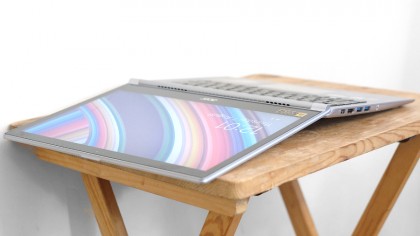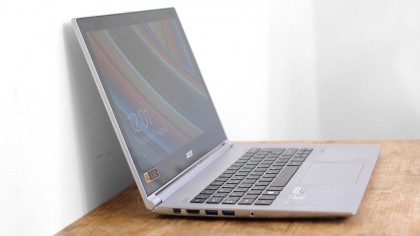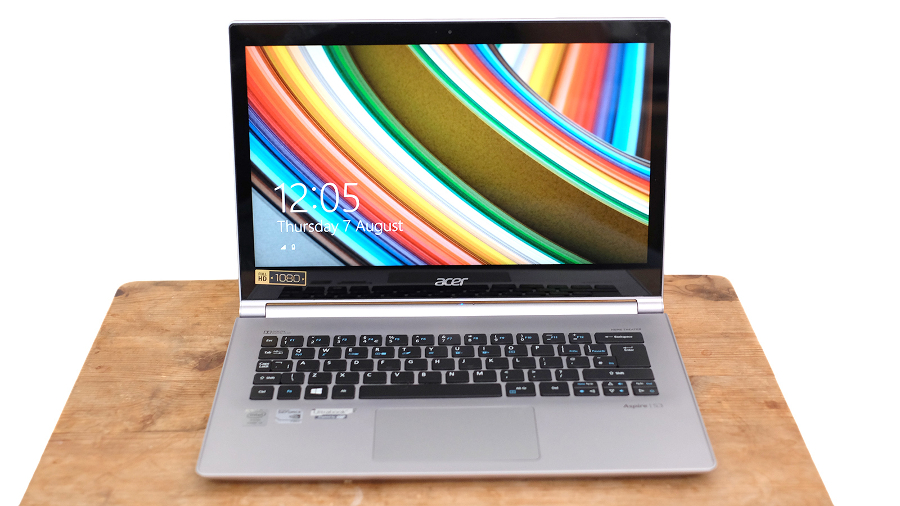Why you can trust TechRadar
Most of the Acer Aspire S3's specs are typical of a mid-range Ultrabook. You get an Intel Core i5 4200U, a pretty battery-conscious 1.6GHz dual-core CPU.
It's no cut-price solution, though – the lower-end version of the Acer Aspire S7 uses the same chipset. What's more likely to prove a bit of a performance bottleneck for some is the 4GB of RAM.
Most Ultrabooks at this price have 4GB of RAM, but if you're going to be doing any video editing or Photoshop editing of lots of high-resolution images at once, you may be better off with an 8GB laptop. There is no 8GB version of the Aspire S3, though, as it's intended largely as an entry-level model filling space between Acer's lower-frills laptops and the Aspire S7.
Benchmarks
- 3DMark: Ice Storm: 36838; Cloud Gate: 4853; Fire Strike: 1033
- Cinebench Graphics: 35.14 fps; CPU: 226 points
- PCMark 8 (Home Test): 2286 points
- PCMark 8 Battery Life: 3 hours 26 minutes
In the PCMark 8 benchmark, the Acer Aspire S3 scores 2286 points, which is just what we'd expect from such a setup. It's similar power to what's on offer in the mid-spec Surface Pro 3, which has an Intel Core i5 4300U processor.
In terms of productivity, the limits depend more on your patience than the Aspire S3's specs. It's capable of running just about anything, it's just not a powerhouse.
Of course, in a laptop like this we're just as interested in its gaming performance. The Acer Aspire S3 is one of just a few slim laptops to offer dedicated graphics hardware.

Tech specs
Here's the full spec sheet of the laptop:
- CPU: 1.6GHz Intel Core i5 4200U
- Graphics: GeForce 735M 1GB
- RAM: 4GB DDR3 SDRAM
- Screen: 13.3-inch, 1920 x 1080 IPS
- Storage: 500GB with 16GB SSD storage
- Ports: 2 x USB 3.0, 1 x USB 2.0, HDMI-out, SD, Acer converter socket, headphone jack
- Connectivity: 802.11b/g/n Wi-Fi, Bluetooth
- Camera: 720p webcam
- Weight: 1.55kg
- Size: 323.5 x 225 x 17.8mm
It has a GeForce 735M card with 1GB of RAM. This is a fair bit better than the integrated Intel HD 4400 graphics you'd get in a rival without a dedicated GPU. For example, its 1033 Fire Strike 3DMark score is about 70% better than what you'd get from an Intel HD 4400.
However, gamers looking for a true gaming Ultrabook need to manage their expectations. The GeForce 735M is a low-end card, and can only really handle fairly old games at anything but low-end settings. Don't buy the Aspire S3 thinking you'll be able to play some of the latest console ports at 1080p with AA and high detail settings.
Real-world testing
For a more real-life test, we tried out Two Worlds II, released in late 2010. At 1080p resolution without AA, but with high detail and full shadow/lighting effect there were pretty bad frame rate dips as soon as we came to any busy moments or physics-heavy sections.
We needed to drop down to 1600 x 900 resolution to make the game playable, or reduce things like shadows, bloom lighting effects and texture detail to mid or low levels. The game still looks good, but let's remember – this is with a four year-old game. It still seems likely that the 735M will surpass the next generation, Intel Broadwell, integrated GPU performance at this Core i5 level, but it probably won't be too far off.
General performance is fairly good thanks to the 16GB SSD, which is used to offer faster booting from both a quick sleep and from cold. Just close down the Aspire S3 briefly and you'll be back up and running within about two seconds, or it takes around 10-12 seconds to boot the laptop from an actual shutdown. That's not bad.
We didn't find that the Aspire S3 got at all hot with general productivity use, staying mostly silent. If you're going to work in a very quiet environment you may notice the little clicks and whirrs of the laptop's HDD, but it's nothing major.

Battery downsides
So you get the performance you expect from an Ultrabook, plus a smidge of extra gaming capability without adding a great deal to the Aspire S3's weight or thickness. What's not to like?
Whether it's down to the use of a dedicated GPU or relatively small 4-cell battery or, more likely, a combination of both, battery stamina is not very good for a device of this class. In our PCMark 8 battery benchmark, which measures general productivity/light gaming stamina with maximum screen brightness, the Acer Aspire S3 lasted for just three hours 26 minutes.
When using the laptop as normal work computer with brightness set around the 50% mark, we were able to increase this to around five hours. However, when you consider that the MacBook Air lasts for up to 13 hours, and the Acer Aspire S7 lasts for a good half hour more in the max brightness PCMark 8 test, it's an altogether disappointing result.
Andrew is a freelance journalist and has been writing and editing for some of the UK's top tech and lifestyle publications including TrustedReviews, Stuff, T3, TechRadar, Lifehacker and others.

